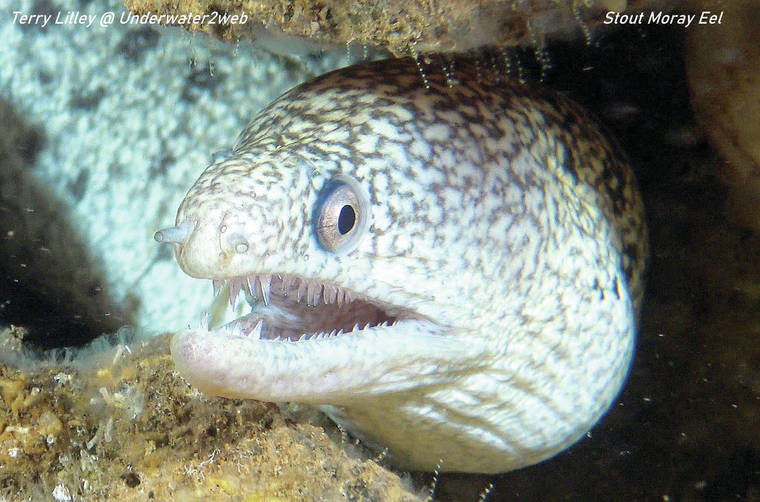This two-foot-long moray eel is the most-common eel in Hawaiian waters, but it is usually misidentified. The Hawaiians only gave it the general name “puhi,” which is the first name for all of the morays. But they did not give it a second name, more than likely due to the many different colors this eel can have.
This two-foot-long moray eel is the most-common eel in Hawaiian waters, but it is usually misidentified. The Hawaiians only gave it the general name “puhi,” which is the first name for all of the morays. But they did not give it a second name, more than likely due to the many different colors this eel can have.
They range from white, golden, solid brown to black with white dots! They can even be the exact same color as the white-mouth moray, but they lack the white mouth. For many years the stout moray was classified as several different species until DNA studies showed they are all the same species but different polymorphs or color variations. I even have video of one stout moray that is solid brown with half its head pure white!
Divers often see this moray sticking its head out of a little hole in the reef during the day, but they normally come out at night to feed on small fish, of which they grab with their sharp teeth and swallow whole like a snake would feed on land. When divers approach one of these small eels, they get nervous and open their mouths, showing their very-sharp teeth. They are not trying to bite, but they breathe through their mouth, and when they get excited they breathe more. They are quite curious with divers, and if you remain very still and scratch the reef by their hole with your finger they will often come out of their den to visit.
Stout moray eels are so common in Hawai‘i that I have seen six different colored specimens on a single, hour-long scuba dive! These eels are a perfect size to be eaten by large predator fish like the ulua and grouper, but here in Hawai‘i we have very few large predator fish compared to other tropical islands. In Palau all the way south to Tahiti, moray eels are rare, and it is a real treat to see even a single eel on an hour dive. Most of the tropical Pacific Islands have good grouper populations that feed on the smaller species of moray eels, but here in Hawai‘i groupers are quite rare. Out of all of the dives I have done worldwide, Hawai‘i is the best place to visit with puhi, and in old Hawai‘i the eels were so common right up into the tide pools that they were easily speared for food.
You can see puhi in action in my underwater educational movie “The World’s Guide To Hawaiian Reef Fish” up on my marine science web page at underwater2web.com. We have an entire marine-life- and coral-reef-movie series that is super educational and fun to show in the school classroom.
•••
Terry Lilley is a marine biologist living in Hanalei and co-founder of Reef Guardians Hawai‘i, a nonprofit on a mission to provide education and resources to protect the coral reef. To donate to Reef Guardians Hawaii go to reefguardianshawaii.org.

Subscribe today for unlimited access.
Already a subscriber?
Login
Not ready to subscribe?
Register for limited access.
If you have a print subscription but require digital access,
activate your account.




